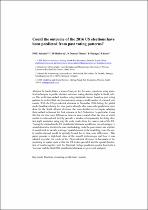 ResearchSpace
ResearchSpace
Could the outcome of the 2016 US elections have been predicted from past voting patterns?
JavaScript is disabled for your browser. Some features of this site may not work without it.
- ResearchSpace
- →
- Research Publications/Outputs
- →
- Conference Publications
- →
- View Item
| dc.contributor.author |
Schmitz, P

|
|
| dc.contributor.author |
Holloway, Jennifer P

|
|
| dc.contributor.author |
Dudeni-Tlhone, Nontembeko

|
|
| dc.contributor.author |
Ntlangu, Mbulelo B

|
|
| dc.contributor.author |
Koen, Renée

|
|
| dc.date.accessioned | 2017-09-29T06:46:49Z | |
| dc.date.available | 2017-09-29T06:46:49Z | |
| dc.date.issued | 2017-07 | |
| dc.identifier.citation | Schmitz, P.M.U., Holloway, J.P., Dudeni-Tlhone, N. et al. 2017. Could the outcome of the 2016 US elections have been predicted from past voting patterns? 28th International Cartographic Conference, 2-7 July 2017, Washington DC, USA | en_US |
| dc.identifier.uri | https://www.eventscribe.com/2017/ICC/ajaxcalls/PresentationInfo.asp?efp=T01ITVFBT0gyNjgy&PresentationID=259432&rnd=0.1063697 | |
| dc.identifier.uri | http://hdl.handle.net/10204/9614 | |
| dc.description | 28th International Cartographic Conference, 2-7 July 2017, Washington DC, USA | en_US |
| dc.description.abstract | In South Africa, a team of analysts has for some years been using statistical techniques to predict election outcomes during election nights in South Africa. The prediction method involves using statistical clusters based on past voting patterns to predict final election outcomes, using a small number of released vote counts. With the US presidential elections in November 2016 hitting the global media headlines during the time period directly after successful predictions were done for the South African elections, the team decided to investigate adapting their method to forecast the final outcome in the US elections. In particular, it was felt that the time zone differences between states would affect the time at which results are released and thereby provide a window of opportunity for doing election night prediction using only the early results from the eastern side of the US. Testing the method on the US presidential elections would have two advantages: it would determine whether the core methodology could be generalised, and whether it would work to include a stronger spatial element in the modelling, since the early results released would be spatially biased due to time zone differences. This paper presents a high-level view of the overall methodology and how it was adapted to predict the results of the US presidential elections. A discussion on the clustering of spatial units within the US is also provided and the spatial distribution of results together with the Electoral College prediction results from both A ‘test-run’ and the final 2016 presidential elections are given and analysed. | en_US |
| dc.language.iso | en | en_US |
| dc.relation.ispartofseries | Worklist;19538 | |
| dc.subject | Election outcome predictions | en_US |
| dc.subject | United States elections | en_US |
| dc.subject | Voting patterns | en_US |
| dc.title | Could the outcome of the 2016 US elections have been predicted from past voting patterns? | en_US |
| dc.type | Conference Presentation | en_US |
| dc.identifier.apacitation | Schmitz, P., Holloway, J. P., Dudeni-Tlhone, N., Ntlangu, M. B., & Koen, R. (2017). Could the outcome of the 2016 US elections have been predicted from past voting patterns?. http://hdl.handle.net/10204/9614 | en_ZA |
| dc.identifier.chicagocitation | Schmitz, P, Jennifer P Holloway, Nontembeko Dudeni-Tlhone, Mbulelo B Ntlangu, and Renée Koen. "Could the outcome of the 2016 US elections have been predicted from past voting patterns?." (2017): http://hdl.handle.net/10204/9614 | en_ZA |
| dc.identifier.vancouvercitation | Schmitz P, Holloway JP, Dudeni-Tlhone N, Ntlangu MB, Koen R, Could the outcome of the 2016 US elections have been predicted from past voting patterns?; 2017. http://hdl.handle.net/10204/9614 . | en_ZA |
| dc.identifier.ris | TY - Conference Presentation AU - Schmitz, P AU - Holloway, Jennifer P AU - Dudeni-Tlhone, Nontembeko AU - Ntlangu, Mbulelo B AU - Koen, Renée AB - In South Africa, a team of analysts has for some years been using statistical techniques to predict election outcomes during election nights in South Africa. The prediction method involves using statistical clusters based on past voting patterns to predict final election outcomes, using a small number of released vote counts. With the US presidential elections in November 2016 hitting the global media headlines during the time period directly after successful predictions were done for the South African elections, the team decided to investigate adapting their method to forecast the final outcome in the US elections. In particular, it was felt that the time zone differences between states would affect the time at which results are released and thereby provide a window of opportunity for doing election night prediction using only the early results from the eastern side of the US. Testing the method on the US presidential elections would have two advantages: it would determine whether the core methodology could be generalised, and whether it would work to include a stronger spatial element in the modelling, since the early results released would be spatially biased due to time zone differences. This paper presents a high-level view of the overall methodology and how it was adapted to predict the results of the US presidential elections. A discussion on the clustering of spatial units within the US is also provided and the spatial distribution of results together with the Electoral College prediction results from both A ‘test-run’ and the final 2016 presidential elections are given and analysed. DA - 2017-07 DB - ResearchSpace DP - CSIR KW - Election outcome predictions KW - United States elections KW - Voting patterns LK - https://researchspace.csir.co.za PY - 2017 T1 - Could the outcome of the 2016 US elections have been predicted from past voting patterns? TI - Could the outcome of the 2016 US elections have been predicted from past voting patterns? UR - http://hdl.handle.net/10204/9614 ER - | en_ZA |





